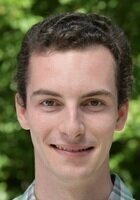All SAT II Biology E Resources
Example Questions
Example Question #1 : Dna Replication And Repair
What type of mutation will code for an amino acid but not the correct or desired amino acid?
Silent mutation
Insertion mutation
Missense mutation
Nonsense mutation
Deletion mutation
Missense mutation
By definition, a missense mutation will still code for an amino acid, but not the desired amino acid. Silent mutations will have a different base pair, but due to the redundancy of genetic code, it will still code for the desired mutation. Nonsense mutations code for an amino acid that leads to a stop codon, which terminates the translation of mRNA into protein. Insertions and deletions result in a shifted reading frame and typically are detrimental.
Example Question #2 : Dna Replication And Repair
Given the partial sequence of a single DNA strand shown below, what will be the sequence of the complementary strand that is produced during DNA replication?
3' - ATCGAAGTGC - 5'
3' - UAGCUUCACG - 5'
5' - TAGCTTCACG - 3'
3' - TAGCTTCACG - 5'
5' - UAGCUUCACG - 3'
5' - ATCGAAGTGC - 3'
5' - TAGCTTCACG - 3'
The question specifies that this is DNA replication. U (uracil) is found only in RNA and T (thymine) is found only in DNA. In DNA, A (adenine) pairs with T (thymine) and G (guanine) pairs with C (cytosine) so the complementary strand will have "A" where the original has "T," "G" where the original has "C," "C" where the original has "G" and "T" where the original has "A."
DNA strands run antiparallel, so the 3' end on the new strand will go opposite the 5' end on the original and vice versa. In this case, that means the complementary strand will run from 5' to 3' to read 5' - TAGCTTCACG - 3'. This sequence is shown in bold below:
5' - TAGCTTCACG - 3'
3' - ATCGAAGTGC - 5'
Example Question #1 : Transcription
What is the dividing structure that separates transcription from translation in a eukaryotic cell?
Mitochondrial matrix
Nuclear envelope
Rough endoplasmic reticulum membrane
Cell membrane
Smooth endoplasmic reticulum membrane
Nuclear envelope
The nuclear envelope separates transcription from translation in a eukaryotic cell. Translation cannot occur until transcription is finished, which is the opposite of what occurs in a prokaryotic cell. In eukaryotic cells, transcription occurs in the nucleus where mRNA will be produced. Once mRNA is produced, it will exit the nucleus through pores and then proceed to be translated into protein in the cytoplasm.
Example Question #2 : Transcription
The trp operon is a repressible operon. Which of the following best describes this type of operon?
None are correct
The operon is usually off and has an inactive repressor
The operon is usually off and has an active repressor
The operon is usually on and has an inactive repressor
The operon is usually on and has an active repressor
The operon is usually on and has an inactive repressor
With a repressible system, the operon is on, meaning the repressor is inactive. Repressible operons are the opposite of inducible operons, which are always off until their repressor is inactivated.
Example Question #3 : Transcription
The lac operon is an inducible operon. Which of the following best describes this type of operon?
The operon is usually on and has an active repressor
The operon is usually off and has an inactive repressor
None of these
The operon is usually on and has an inactive repressor
The operon is usually off and has an active repressor
The operon is usually off and has an active repressor
With an inducible system, the operon is off, meaning its repressor is active, or actively repressing the system from turning on. Inducible operons are opposite to a repressible operon, which is always on until it is repressed.
Example Question #1 : Transcription
At what point does transcription occur in relation to gene expression?
It is the step following translation
It is the first step
Transcription is unrelated to gene expression
It is the last step in this process
Transcription is a process that only occurs in eukaryotes
It is the first step
Transcription is the first process of gene expression and happens before translation.
Example Question #1 : Translation
What happens when one of the three codons of UAG, UAA, or UGA reach the A site on a ribosome that is helping facilitate translation?
Propagation
Termination
Initiation
Processing
Elongation
Termination
UAG, UAA, and UGA are stop codons so when they enter the A site of a ribosome they will initiate the termination of translation.
Example Question #1 : Translation
In eukaryotes, translation of mRNA into a polypeptide is performed by what type of ribosome if the polypeptide is to be secreted from the cell?
A ribosome bound to the rough endoplasmic reticulum
Cytosolic ribosome
A ribosome bound to the plasma membrane
A ribosome bound to the smooth endoplasmic reticulum
A ribosome in the fluid of the nucleus
A ribosome bound to the rough endoplasmic reticulum
The correct answer is a ribosome bound to the rough endoplasmic reticulum. The rough endoplasmic reticulum is covered with bound ribosomes, giving it its “rough” appearance. Proteins that are to be secreted from the cell are translated by ribosomes in the rough ER before moving through the Golgi apparatus and eventually ending up in a vesicle to be secreted from the cell. There are no ribosomes found in the nucleus, bound to smooth ER, or bound to the plasma membrane.
Example Question #1 : Translation
Which of the following mutations is a single nucleotide base pair change that results in a codon for a different amino acid?
Deletion
Nonsense mutation
Silent mutation
Missense mutation
Insertion
Missense mutation
A missense mutation is a type of point mutation (single base pair change) that alters the codon to the creation of a different protein.
A silent mutation is also a point mutation with a change in one base pair, but with the resulting strand still coding for the same protein (hence the term "silent").
A nonsense mutation changes a codon from coding for an amino acid to coding for termination of the protein. The protein may or may not still be functional depending on how much of it is terminated when the mutation occurs.
An insertion is a mutation in which one or more base pairs is added to the coding sequence. Unless the insertion is in a multiple of three (preserving the frame because a codon is made up of three base pairs), it results in a "frame shift" that alters the reading frame of the codons to the right, causing it to code for a different set of proteins.
A deletion is another type of frame shift mutation, in which a base pair (or more) is deleted from the coding sequence, altering the reading frame to code for different proteins in many cases. As with insertions, if the deletion is in a multiple of 3, the frame is preserved as each codon consists of 3 base pairs.
Example Question #1 : Protein Structure
Disulfide bonds can add stability to the structure of a protein. The formation of disulfide bonds occurs in the formation of what level of protein structure?
During translation
Tertiary
Primary
Secondary
Quaternary
Tertiary
The correct answer is "tertiary." Translation is a process performed by ribosomes to link amino acids together in a chain, and the order of the amino acids is based on a code from mRNA. The order of the amino acids in the chain is the primary structure. The secondary structure is the folding in that chain, mainly based on hydrogen bonds between parts of the chain and the surrounding water molecules. The tertiary structure is the actual three-dimensional structure of the protein. Disulfide bonds are covalent bonds between cysteine residues and are stronger than hydrogen bonds and give a stable, three-dimensional structure to what was originally just a chain of amino acids.
All SAT II Biology E Resources




